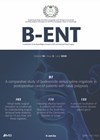
Journal Reviews
Canal wall up mastoid defects - can they be usefully reconstructed with hydroxyapatite cranioplastic cement?
Standard canal wall up (CWU) mastoid surgery leaves a mastoid defect of varying size, commonly covered by soft tissue. Rarely, this bony defect can cause discomfort, cosmetic issues or other problems. To mitigate these, the defect can be filled either...
Long-term curative effects of microvascular decompression for hemifacial spasm
This article describes results of a multicentre prospective trial performed to evaluate long- and short-term outcomes and complications of patients who underwent microvascular decompression (MVD) for hemifacial spasm (HFS). The surgeries were performed by surgeons with more than 15 years...
Lateral skull base surgery using the endoscope
Endoscopic lateral skull base surgery could be performed via less invasive techniques due to wide panoramic visualisation of the operative field. With less invasive techniques, patients have been shown to require shorter recovery time and reduced postoperative pain. In this...
Review of pituitary tumour pathology
This is an excellent review article covering the pathology of pituitary adenomas (PA) as well as rare sellar lesions like lymphocytic hypophysitis that require aggressive treatment. The authors have preserved the 2017 World Health Organization (WHO) classification of PA and...
The medially-invasive cholesteatoma: a case series
In this small case series, Casazza et al describe their management of seven cases of complex cholesteatoma presenting during a 16-year period. Patients were included if imaging confirmed restricted diffusion and an endophytic, medially-destructive disease involving the otic capsule, petrous...
Predictors of diabetes insipidus post-hypophysectomy
Transient diabetes insipidus (DI) after pituitary surgery is not uncommon and its diagnosis fairly obvious. Permanent DI is rare and often depends on the neurosurgeon’s experience. This retrospective study describes a large series of patients with majority undergoing endoscopic transsphenoidal...
Virtual reality surgical simulation for the temporal bone
This prospective study looked at 15 otorhinolaryngology residents in Belgium to see if using the VOXEL-MAN Tempo surgical simulator system improved their understanding of temporal bone radiological anatomy. As a secondary aim, they also assessed whether there was any improvement...
3D-printed temporal bone models - how good can they be?
In the era of increasingly difficult and expensive-to-come-by cadaveric temporal bones with which to practise drilling and learn the complex 3D anatomy of the temporal bone, decent alternatives would be welcome. McMillan et al report a prospective comparison study in...
PET-CT for malignant nasopharyngeal lesions
This retrospective Turkish review of 92 patients aimed to determine the ability of fluorine 18-fluorodeoxyglucose (FDG) maximum standardised uptake value (SUVmax) on positron emission tomography/computerised tomography (PET/CT) to differentiate benign processes and malignant nasopharyngeal lesions. The authors retrospectively reviewed the...
British Skull Base Society Clinical Consensus Document on Management of Head and Neck Paragangliomas (HNPGLs)
All forms of HNPGLs should be managed by a multidisciplinary team (MDT) of core members from skull base otolaryngology, head and neck surgery, clinical genetics, oncology, endocrinology, vascular surgery, radiology and pathology. Extended members include neurosurgery, endocrine surgery, nuclear medicine,...
Olfactory protective effect of omega-3 supplements during healing after endoscopic sellar and parasellar resection
This multicentre study, led by researchers from Stanford, demonstrates another use for omega-3 supplements. The study analysed cohorts equally divided between control arm and omega-3 supplementation. Post endoscopic sellar and parasellar resection, better olfactory function was observed at three and...
Do we need contrast MRI when screening for vestibular schwannoma?
Gadolinium contrast enhanced T1-weighted (gT1w) MRI images of the internal acoustic meati have long been considered the gold standard in the diagnosis of vestibular schwannoma (VS). However, the addition of contrast to the MRI examination increases the cost and time...
















